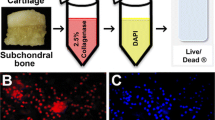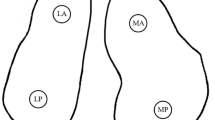Abstract
Surgical techniques including new, possible resources to repair injured joints and damaged cartilage are still evolving. The exact effects of cryopreservation on the collected cartilage samples require accurate determination prior to utilization. The aim of our study was to analyze the impact of cryopreservation at −80 °C on the structural properties of the human cartilage. The effects of storage time were also evaluated in conjunction with optimal utilization. The human cartilage samples were derived during operation and considered to be waste material. Samples were fresh frozen and stored at −80 °C. Cryopreservation times were: 0, 1, 3, 6, and 12 weeks. To assess the biological and structural properties of the frozen human cartilage, we performed calorimetric examinations using differential scanning calorimetry (DSC). During the first 3 weeks, the calorimetric enthalpy (ΔH cal) showed an increasing tendency compared to controls, parallel with the denaturation temperature (T m): ΔH cal (J g−1) = 1.60 versus 2.49, T m1 (°C) = 61.73 versus 63.64. After the sixth week, both the enthalpy and the transition temperature decreased, compared to the control samples. The decrease in both the calorimetric enthalpy and T m could be explained by the decrease in bound water and the time-related degeneration in the structure of the cartilage. Here we found that the duration of cryopreservation interferes with the morphology of human cartilage samples only after 6 weeks of storage time. The thermal analyzes of human cartilage by DSC could be a useful method to follow the morphological changes in the clinical practice.



Similar content being viewed by others
References
Sebestyén A, Boncz I, Sándor J, Nyárády J. Effect of surgical delay on early mortality in patients with femoral neck fracture. Int Orthop (SICOT). 2008;32:375–9. doi:10.1007/s00264-007-0331-z.
Sebestyén A, Tóth F, Sándor J, Nyárády J, Boncz I. Correlation between risk factors and subsequent surgical management following internal fixation of intracapsular femoral neck fractures in patients under the age 60 years. Eur J Trauma Emerg Surg. 2011;37:503–10.
Sebestyén A, Boncz I, Tóth F, Péntek M, Nyárády J, Sándor J. Időskori combnyaktöréseket követő halálozás és kockázati tényezőik kapcsolatának értékelése 5 éves utánkövetéssel. Hungarian article. Orvosi Hetilap. 2008;149:493–503.
Heetveld MJ, Rogmark C, Frihagen F, Keating J. Internal fixation versus arthroplasty for displaced femoral neck fractures: what is the evidence? J Orthop Trauma. 2009;23:395–402.
Gjertsen JE, Vinje T, Engesaeter LB, Lie SA, Havelin LI, Furnes O, Fevang JM. Internal screw fixation compared with bipolar hemiarthroplasty for treatment of displaced femoral neck fractures in elderly patients. J Bone Joint Surg Am. 2010;92:619–28.
Hangody L, Füles P. Autologous osteochondral mosaicplasty for the treatment of full-thickness defects of weight-bearing joints: ten years of experimental and clinical experience. J Bone Joint Surg Am. 2003;85-A(Suppl 2):25–32.
Hangody L, Dobos J, Baló E, Pánics G, Hangody LR, Berkes I. Clinical experiences with autologous osteochondral mosaicplasty in an athletic population: a 17-year prospective multicenter study. Am J Sports Med. 2010;38:1125–33.
Khanna V, Tushinski DM, Drexler M, Backstein DB, Gross AE, Safir OA, Kuzyk PR. Cartilage restoration of the hip using fresh osteochondral allograft: resurfacing the potholes. Bone Joint J. 2014;96-B(11 Supple A):11–6. doi:10.1302/0301-620X.96B11.34734.
Musumeci G, Loreto C, Castorina S, Imbesi R, Leonardi R, Castrogiovanni P. Current concepts in the treatment of cartilage damage. A review. Ital J Anat Embriol Rev Cytol Cell Biol. 2013;118:189–203.
Könczöl F, Wiegand N, Nöt LG, Lőrinczy D. Examination of the cyclophosphamide induced polyneuropathy on Guinea pig sciatic nerve and gastrocnemius muscle with differential scanning calorimetry. J Therm Anal Calorim. 2014;115:2239–43.
Mehdi M, Ferencz A, Lőrinczy D. Evaluation of blood plasma changes by differential scanning calorimetry in psoriatic patients treated with drugs. J Therm Anal Calorim. 2014;116:557–62.
Sillinger T, Lőrinczy D, Kocsis B, Kereskay L, Nöt LG, Wiegand N. Differential scanning calorimetric measurement of cartilage destruction caused by gram-negative septic arthritis. J Therm Anal Calorim. 2014;116:747–52.
Lőrinczy D. The “Green Issue” of JTAC as a great idea of Judit Simon. J Therm Anal Calorim. 2015;120:13–22.
Sillinger T, Than P, Kocsis B, Lőrinczy D. DSC measurement of cartilage destruction caused by septic arthritis. J Therm Anal Calorim. 2005;82:221–3.
Than P, Vermes CS, Schäffer B, Lőrinczy D. Differential scanning calorimetric examination of the human hyaline cartilage: a preliminary study. Thermochim Acta. 2000;346:147–51.
Naumov I, Wiegand N, Patczai B, Vámhidy L, Lőrinczy D. Differential scanning calorimetric examination of the human hyaline cartilage of the femoral head after femoral neck fracture. J Therm Anal Calorim. 2012;108:59–65.
Pearsall AW, Tucker JA, Hester RB, Heitman RJ. Chondrocyte viability in refrigerated osteochondral allografts used for transplantation within the knee. Am J Sports Med. 2004;32:125–31.
Allen RT, Robertson CM, Pennock AT, Bugbee WD, Harwood FL, Wong VW, Chen AC, Sah RL, Amiel D. Analysis of stored osteochondral allografts at the time of surgical implantation. Am J Sports Med. 2005;33:1479–84.
Gole MD, Poulsen D, Marzo JM, Ko SH, Ziv I. Chondrocyte viability in press-fit cryopreserved osteochondral allografts. J Orthop Res. 2004;22:781–7.
Bakay A, Csonge L, Papp G, Fekete L. Osteochondral resurfacing of the knee joint with allograft. Clinical analysis of 33 cases. Int Orthop. 1998;22:277–81.
Schachar NS, Novak K, Hurtig M, Muldrew K, McPherson R, Wohl G, Zernicke RF, McGann LE. Transplantation of cryopreserved osteochondral dowel allografts for repair of focal articular defects in an ovine model. J Orthop Res. 1999;17:909–19.
Naumov I, Lőrinczy D, Vámhidy L, Than P, Wiegand N. Differential scanning calorimetric examination of the interfacial membrane in failed hip joint replacements. J Therm Anal Calorim. 2012;109:783–7.
Nöt LG, Naumov I, Vámhidy L, Lőrinczy D, Wiegand N. Comparison of thermal characteristics of degenerated and inflamed human collagen structures with differential scanning calorimetry. J Therm Anal Calorim. 2013;113:273–9.
Wiegand N, Naumov I, Vámhidy L, Kereskai L, Lőrinczy D, Nőt LG. Comparative calorimetric analysis of 13 different types of human healthy and pathologic collagen tissues. Thermochim Acta. 2014;568:171–4.
Acknowledgements
This work was supported by the following grant: OTKA CO-272 (for Dénes Lőrinczy). The present scientific contribution is dedicated to the 650th anniversary of the foundation of the University of Pécs, Hungary.
Author information
Authors and Affiliations
Corresponding author
Rights and permissions
About this article
Cite this article
Patczai, B., Mintál, T., Nőt, L.G. et al. Effects of deep-freezing and storage time on human femoral cartilage. J Therm Anal Calorim 127, 1177–1180 (2017). https://doi.org/10.1007/s10973-016-5365-2
Received:
Accepted:
Published:
Issue Date:
DOI: https://doi.org/10.1007/s10973-016-5365-2




